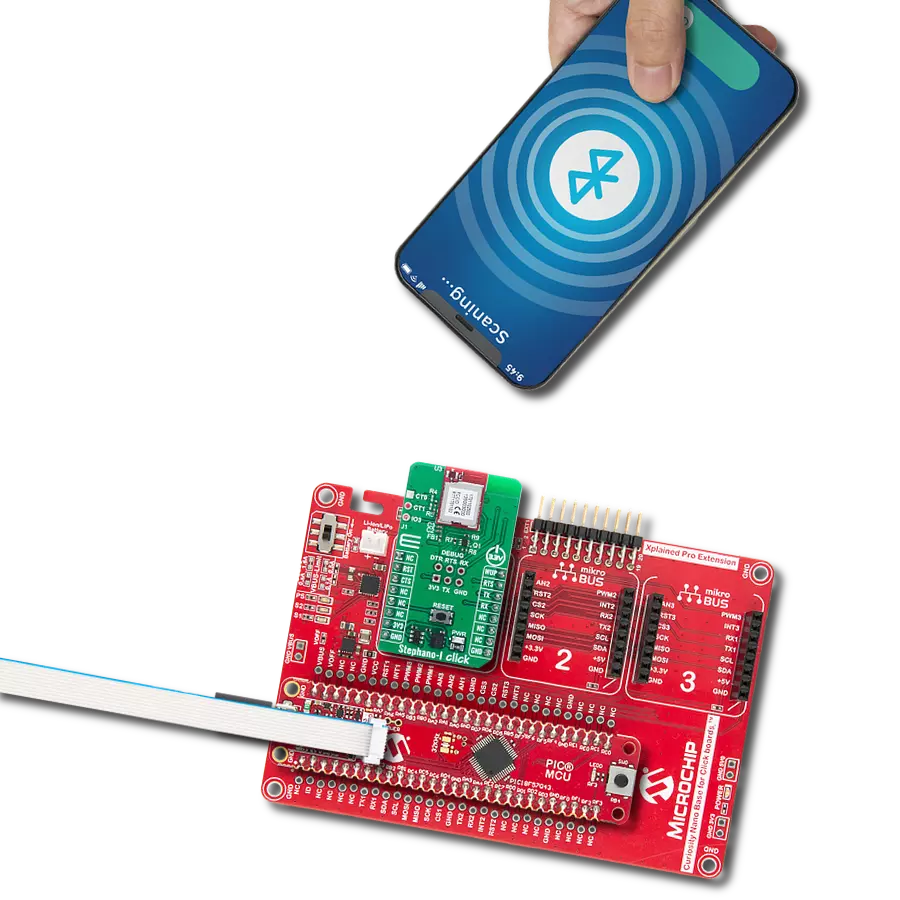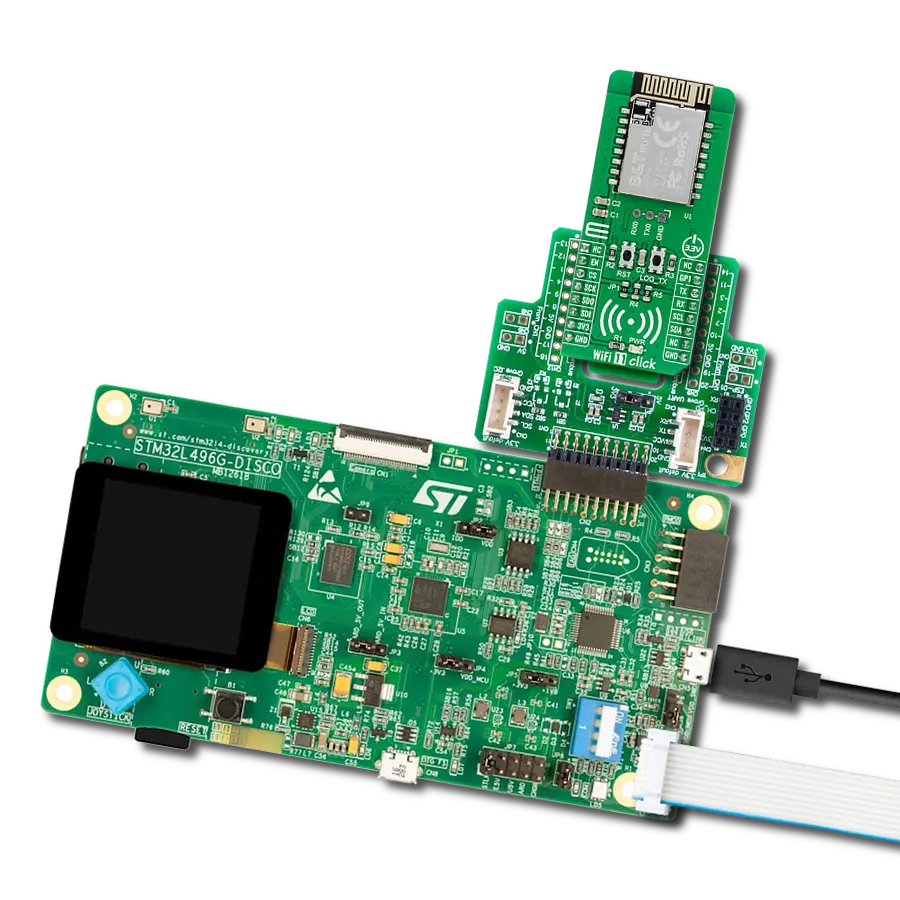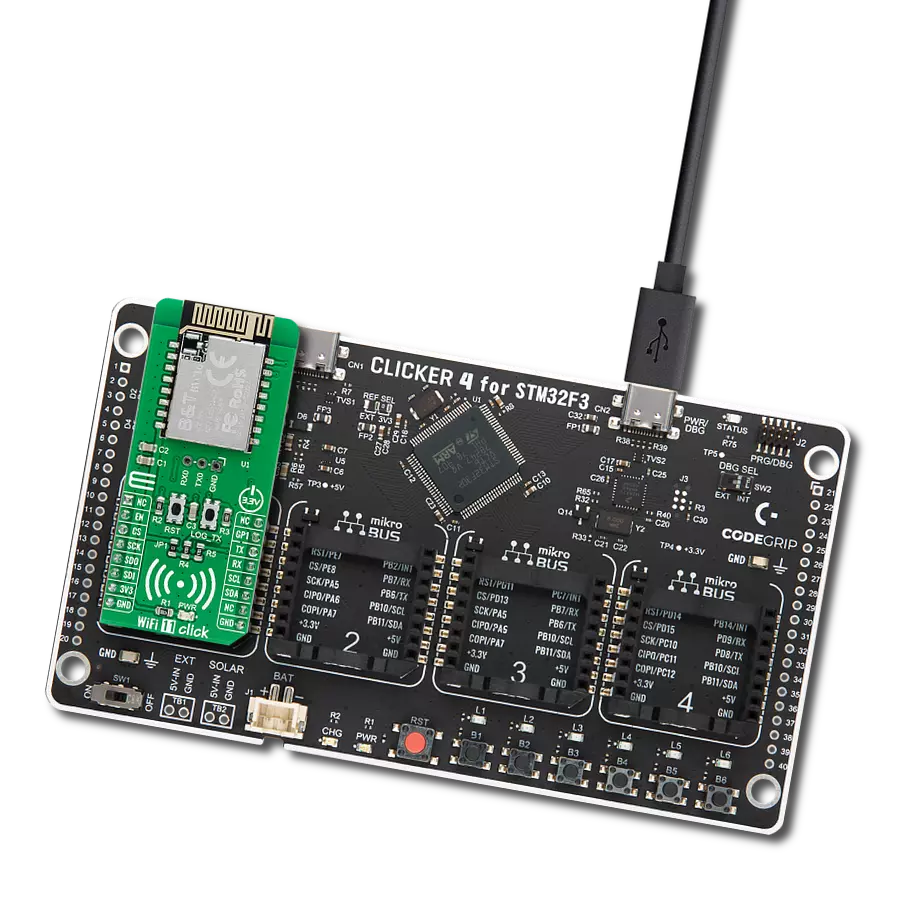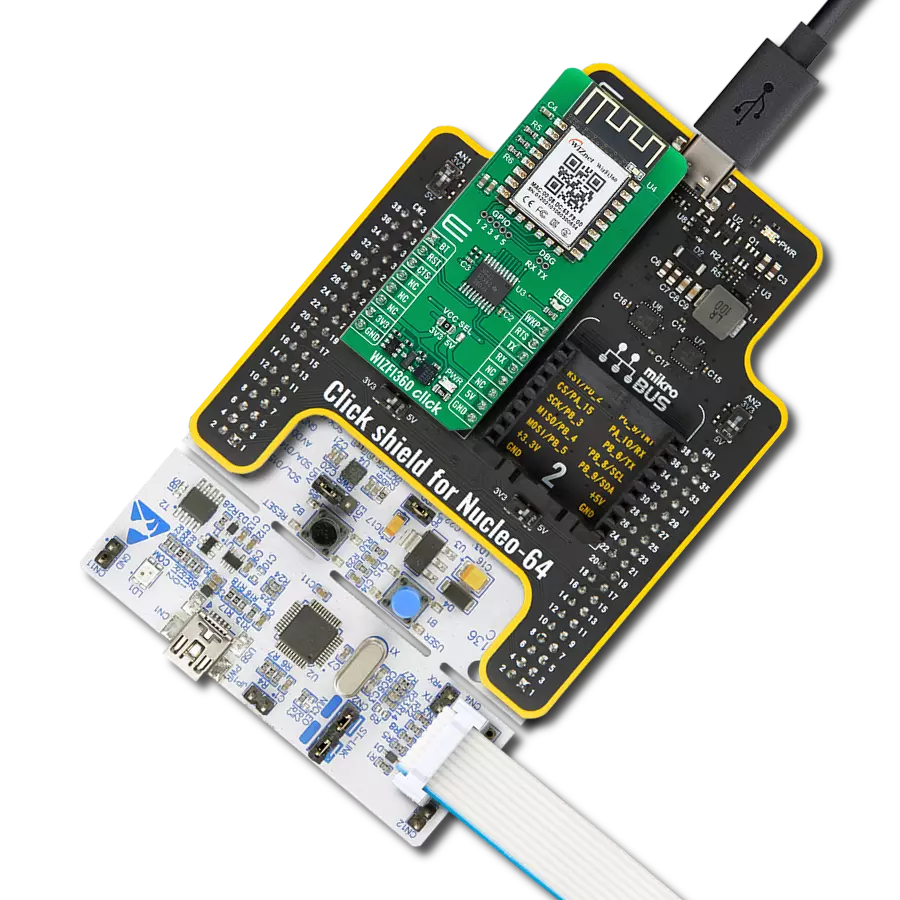实现无线WiFi和BLE技术的轻松集成,同时具备高级安全性和能源效率,非常适合开发智能设备和物联网应用。
A
A
硬件概览
它是如何工作的?
Ai-WB2-12F Click基于Ai-Thinker Technology的Ai-WB2-12F,这是一个WiFi和BLE模块。在其核心是BL602芯片,作为主要处理器。该芯片为模块提供了对WiFi 802.11b/g/n和BLE 5.0协议的支持,具有低功耗32位RISC CPU、276KB RAM以及一系列外围接口,如SDIO、SPI、UART、I2C、IR Remote、PWM、ADC、DAC、PIR和GPIO等。它的设计旨在广泛应用于物联网(IoT)、可穿戴技术、智能家居解决方案等领域。在附加规格方面,该模块具有内置的PCB天线,覆盖了2400到2483.5MHz的频率范围,以及广泛的WiFi安全协议,包括WPS、WEP、WPA、WPA2 Personal、WPA2 Enterprise和WPA3。它
还支持BLE 5.0和蓝牙Mesh,各种操作模式,如Station + BLE和Station + SoftAP + BLE,具有ECC-256签名镜像的安全启动、用于128/192/256位密钥的AES加密引擎、真随机数生成器和用于广泛的加密操作的公钥加速器。该模块支持各种睡眠模式,具有仅12μA的深度睡眠电流,并允许使用通用AT命令进行简单设置。至于板的连接特性,这个Click板™采用UART接口与主机MCU通信,使用标准的UART RX和TX引脚来交换AT命令。默认情况下,它以115200bps的波特率进行通信。此外,该Click板™还配备了一个USB-C连接器,可通过PC进行直接供电和配置。该板还通过与mikroBUS™插座的EN引脚连接的R5电阻(默认情况下未装
载R5电阻)实现了复位功能,具有用于模块启用的EN按钮以及用于固件编程的PROG按钮。RGB二极管用作状态指示器,红色表示IO14的活动IO引脚,绿色表示IO17,蓝色表示IO3。根据用户的需求,这些引脚可以适应各种用途,如SPI、PWM或ADC。可用户配置的IO引脚默认不可用。如果需要使用,请联系Ai-Thinker。此Click板™只能使用3.3V逻辑电压电平。在使用具有不同逻辑电平的MCU之前,板必须执行适当的逻辑电压电平转换。此外,它配备了一个包含函数和示例代码的库,可用作进一步开发的参考。
功能概述
开发板
Clicker 2 for Kinetis 是一款紧凑型入门开发板,它将 Click 板™的灵活性带给您喜爱的微控制器,使其成为实现您想法的完美入门套件。它配备了一款板载 32 位 ARM Cortex-M4F 微控制器,NXP 半导体公司的 MK64FN1M0VDC12,两个 mikroBUS™ 插槽用于 Click 板™连接,一个 USB 连接器,LED 指示灯,按钮,一个 JTAG 程序员连接器以及两个 26 针头用于与外部电子设备的接口。其紧凑的设计和清晰、易识别的丝网标记让您能够迅速构建具有独特功能和特性
的小工具。Clicker 2 for Kinetis 开发套件的每个部分 都包含了使同一板块运行最高效的必要组件。除了可以选择 Clicker 2 for Kinetis 的编程方式,使用 USB HID mikroBootloader 或外部 mikroProg 连接器进行 Kinetis 编程外,Clicker 2 板还包括一个干净且调节过的开发套件电源供应模块。它提供了两种供电方式;通过 USB Micro-B 电缆,其中板载电压调节器为板上每个组件提供适当的电压水平,或使用锂聚合物 电池通过板载电池连接器供电。所有 mikroBUS™ 本
身支持的通信方法都在这块板上,包括已经建立良好的 mikroBUS™ 插槽、重置按钮和几个用户可配置的按钮及 LED 指示灯。Clicker 2 for Kinetis 是 Mikroe 生态系统的一个组成部分,允许您在几分钟内创建新的应用程序。它由 Mikroe 软件工具原生支持,得益于大量不同的 Click 板™(超过一千块板),其数量每天都在增长,它涵盖了原型制作的许多方面。
微控制器概述
MCU卡片 / MCU
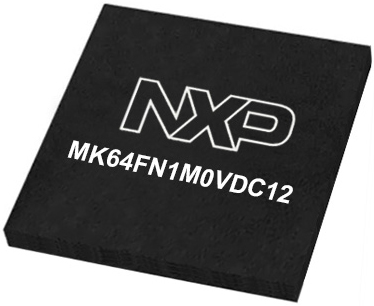
建筑
ARM Cortex-M4
MCU 内存 (KB)
1024
硅供应商
NXP
引脚数
121
RAM (字节)
262144
使用的MCU引脚
mikroBUS™映射器
“仔细看看!”
Click board™ 原理图
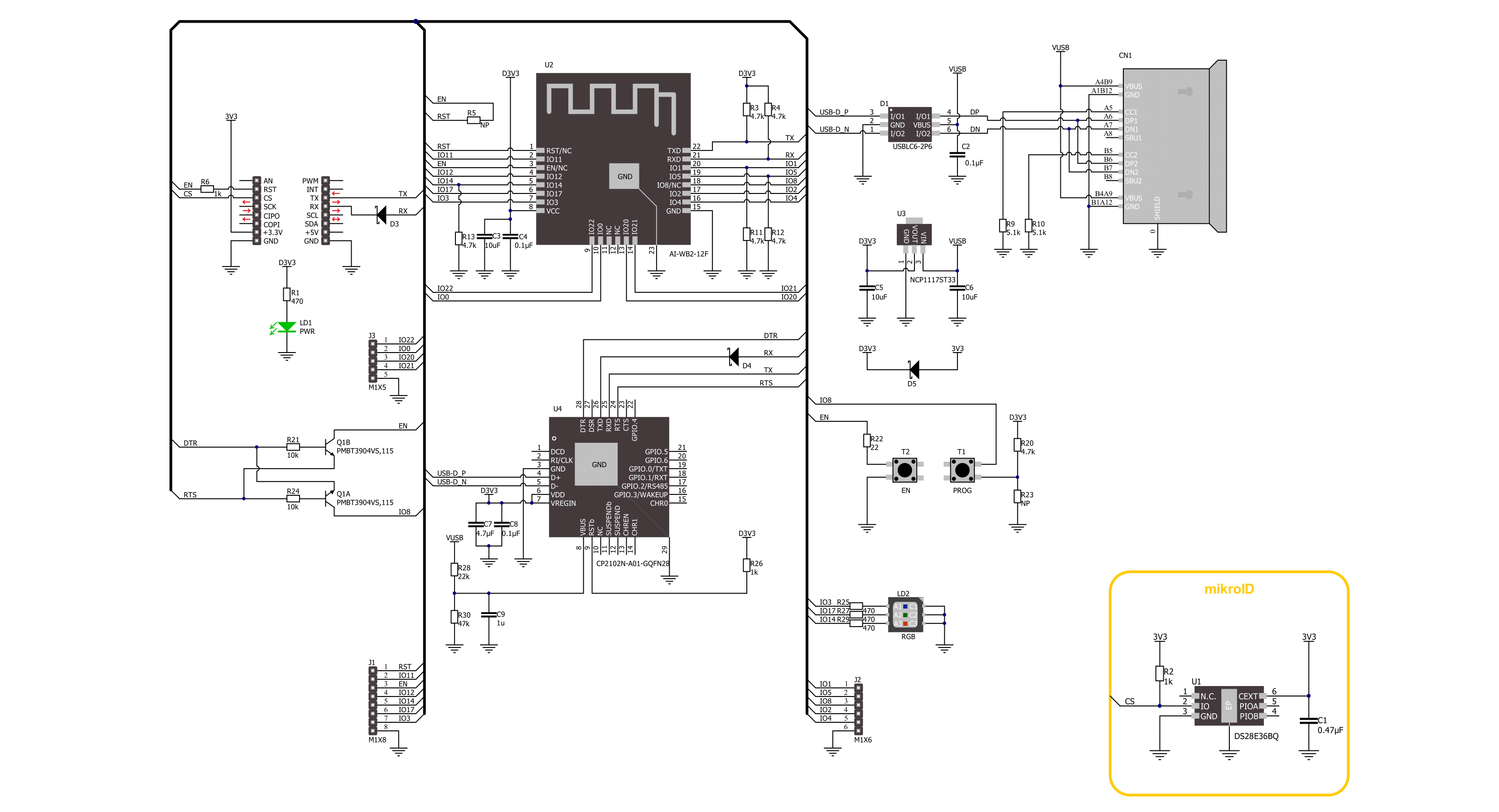
一步一步来
项目组装
实时跟踪您的结果
应用程序输出
1. 应用程序输出 - 在调试模式下,“应用程序输出”窗口支持实时数据监控,直接提供执行结果的可视化。请按照提供的教程正确配置环境,以确保数据正确显示。

2. UART 终端 - 使用UART Terminal通过USB to UART converter监视数据传输,实现Click board™与开发系统之间的直接通信。请根据项目需求配置波特率和其他串行设置,以确保正常运行。有关分步设置说明,请参考提供的教程。

3. Plot 输出 - Plot功能提供了一种强大的方式来可视化实时传感器数据,使趋势分析、调试和多个数据点的对比变得更加直观。要正确设置,请按照提供的教程,其中包含使用Plot功能显示Click board™读数的分步示例。在代码中使用Plot功能时,请使用以下函数:plot(insert_graph_name, variable_name);。这是一个通用格式,用户需要将“insert_graph_name”替换为实际图表名称,并将“variable_name”替换为要显示的参数。

软件支持
库描述
该库包含 Ai-WB2-12F Click 驱动程序的 API。
关键功能:
aiwb212f_send_cmd- Ai-WB2-12F发送命令功能aiwb212f_send_cmd_with_par- Ai-WB2-12F带参数发送命令功能aiwb212f_send_cmd_check- Ai-WB2-12F发送命令检查功能
开源
代码示例
完整的应用程序代码和一个现成的项目可以通过NECTO Studio包管理器直接安装到NECTO Studio。 应用程序代码也可以在MIKROE的GitHub账户中找到。
/*!
* @file main.c
* @brief Ai-WB2-12F Click Example.
*
* # Description
* This example demonstrates the use of Ai-WB2-12F Click board by processing
* the incoming data and displaying them on the USB UART.
*
* The demo application is composed of two sections :
*
* ## Application Init
* Initializes the driver, tests the communication, and after that restarts the device, and performs example configuration.
*
* ## Application Task
* Depending on the selected demo example, it sends a TCP/UDP echo server message and receives it or
* creates BLE Client which receives the messages from the connected device.
*
* ## Additional Function
* - static void aiwb212f_clear_app_buf ( void )
* - static void aiwb212f_log_app_buf ( void )
* - static err_t aiwb212f_process ( aiwb212f_t *ctx )
* - static void aiwb212f_rsp_check ( void )
* - static void aiwb212f_error_check ( void )
* - static void aiwb212f_configure_for_example ( void )
* - static void aiwb212f_example ( void )
*
* @note
* We have used the BLE Scanner Android application for the BLE Example test
* and you can find it at the link:
* https://play.google.com/store/apps/details?id=com.macdom.ble.blescanner
*
* @author Stefan Ilic
*
*/
#include "board.h"
#include "log.h"
#include "aiwb212f.h"
// Example selection macros
#define EXAMPLE_TCP_UDP 0 // Example of sending messages to a TCP/UDP echo server
#define EXAMPLE_BLE 1 // BLE Example
#define DEMO_EXAMPLE EXAMPLE_TCP_UDP // Example selection macro
// Message content
#define MESSAGE_CONTENT "Ai-WB2-12F Click board - demo example."
#define MESSAGE_LEN "40"
// TCP/UDP example parameters
#define REMOTE_IP "77.46.162.162" // TCP/UDP echo server IP address
#define REMOTE_PORT "51111" // TCP/UDP echo server port
// WiFi parameters
#define WIFI_SSID "MikroE Public"
#define WIFI_PWD "mikroe.guest"
// GPIO parameters
#define LED_RED_GPIO "5"
#define LED_GREEN_GPIO "6"
#define LED_BLUE_GPIO "7"
// Application buffer size
#define APP_BUFFER_SIZE 200
#define PROCESS_BUFFER_SIZE 200
static aiwb212f_t aiwb212f;
static log_t logger;
static err_t error_flag;
static uint8_t app_buf[ APP_BUFFER_SIZE ] = { 0 };
static int32_t app_buf_len = 0;
/**
* @brief Ai-WB2-12F clearing application buffer.
* @details This function clears memory of application buffer and reset its length.
* @note None.
*/
static void aiwb212f_clear_app_buf ( void );
/**
* @brief Ai-WB2-12F log application buffer.
* @details This function logs data from application buffer to USB UART.
* @note None.
*/
static void aiwb212f_log_app_buf ( void );
/**
* @brief Ai-WB2-12F data reading function.
* @details This function reads data from device and concatenates data to application buffer.
* @return @li @c 0 - Read some data.
* @li @c -1 - Nothing is read.
* See #err_t definition for detailed explanation.
* @note None.
*/
static err_t aiwb212f_process ( void );
/**
* @brief Response check.
* @details This function checks for response and
* returns the status of response.
* @param[in] rsp Expected response.
* @return @li @c 0 - OK response.
* @li @c -1 - Error response.
* @li @c -2 - Timeout error.
* @li @c -3 - Unknown error.
* See #err_t definition for detailed explanation.
*/
static err_t aiwb212f_rsp_check ( uint8_t *rsp );
/**
* @brief Check for errors.
* @details This function checks for different types of
* errors and logs them on UART or logs the response if no errors occured.
* @param[in] error_flag Error flag to check.
*/
static void aiwb212f_error_check ( err_t error_flag );
/**
* @brief Ai-WB2-12F configure for example function.
* @details This function is used to configure device for example.
*/
static void aiwb212f_configure_for_example ( void );
/**
* @brief Ai-WB2-12F execute example function.
* @details This function executes TCP/UDP or BLE example depending on the DEMO_EXAMPLE macro.
*/
static void aiwb212f_example ( void );
void application_init ( void )
{
log_cfg_t log_cfg; /**< Logger config object. */
aiwb212f_cfg_t aiwb212f_cfg; /**< Click config object. */
/**
* Logger initialization.
* Default baud rate: 115200
* Default log level: LOG_LEVEL_DEBUG
* @note If USB_UART_RX and USB_UART_TX
* are defined as HAL_PIN_NC, you will
* need to define them manually for log to work.
* See @b LOG_MAP_USB_UART macro definition for detailed explanation.
*/
LOG_MAP_USB_UART( log_cfg );
log_init( &logger, &log_cfg );
log_info( &logger, " Application Init " );
// Click initialization.
aiwb212f_cfg_setup( &aiwb212f_cfg );
AIWB212F_MAP_MIKROBUS( aiwb212f_cfg, MIKROBUS_1 );
if ( UART_ERROR == aiwb212f_init( &aiwb212f, &aiwb212f_cfg ) )
{
log_error( &logger, " Communication init." );
for ( ; ; );
}
aiwb212f_process( );
aiwb212f_clear_app_buf( );
aiwb212f_hw_reset( &aiwb212f );
error_flag = aiwb212f_rsp_check( AIWB212F_RSP_READY );
aiwb212f_error_check( error_flag );
// Check communication
aiwb212f_send_cmd( &aiwb212f, AIWB212F_CMD_AT );
error_flag = aiwb212f_rsp_check( AIWB212F_RSP_OK );
aiwb212f_error_check( error_flag );
// Restart device
aiwb212f_send_cmd( &aiwb212f, AIWB212F_CMD_AT_SW_RESET );
error_flag = aiwb212f_rsp_check( AIWB212F_RSP_READY );
aiwb212f_error_check( error_flag );
aiwb212f_configure_for_example( );
log_info( &logger, " Application Task " );
}
void application_task ( void )
{
aiwb212f_example( );
}
int main ( void )
{
/* Do not remove this line or clock might not be set correctly. */
#ifdef PREINIT_SUPPORTED
preinit();
#endif
application_init( );
for ( ; ; )
{
application_task( );
}
return 0;
}
static void aiwb212f_clear_app_buf ( void )
{
memset( app_buf, 0, app_buf_len );
app_buf_len = 0;
}
static void aiwb212f_log_app_buf ( void )
{
for ( int32_t buf_cnt = 0; buf_cnt < app_buf_len; buf_cnt++ )
{
log_printf( &logger, "%c", app_buf[ buf_cnt ] );
}
}
static err_t aiwb212f_process ( void )
{
uint8_t rx_buf[ PROCESS_BUFFER_SIZE ] = { 0 };
int32_t overflow_bytes = 0;
int32_t rx_cnt = 0;
int32_t rx_size = aiwb212f_generic_read( &aiwb212f, rx_buf, PROCESS_BUFFER_SIZE );
if ( ( rx_size > 0 ) && ( rx_size <= APP_BUFFER_SIZE ) )
{
if ( ( app_buf_len + rx_size ) > APP_BUFFER_SIZE )
{
overflow_bytes = ( app_buf_len + rx_size ) - APP_BUFFER_SIZE;
app_buf_len = APP_BUFFER_SIZE - rx_size;
memmove ( app_buf, &app_buf[ overflow_bytes ], app_buf_len );
memset ( &app_buf[ app_buf_len ], 0, overflow_bytes );
}
for ( rx_cnt = 0; rx_cnt < rx_size; rx_cnt++ )
{
if ( rx_buf[ rx_cnt ] )
{
app_buf[ app_buf_len++ ] = rx_buf[ rx_cnt ];
}
}
return AIWB212F_OK;
}
return AIWB212F_ERROR;
}
static err_t aiwb212f_rsp_check ( uint8_t *rsp )
{
uint32_t timeout_cnt = 0;
uint32_t timeout = 120000;
aiwb212f_clear_app_buf( );
aiwb212f_process( );
while ( ( 0 == strstr( app_buf, rsp ) ) &&
( 0 == strstr( app_buf, AIWB212F_RSP_ERROR ) ) )
{
aiwb212f_process( );
if ( timeout_cnt++ > timeout )
{
aiwb212f_clear_app_buf( );
return AIWB212F_ERROR_TIMEOUT;
}
Delay_ms ( 1 );
}
Delay_ms ( 100 );
aiwb212f_process( );
if ( strstr( app_buf, rsp ) )
{
return AIWB212F_OK;
}
else if ( strstr( app_buf, AIWB212F_RSP_ERROR ) )
{
return AIWB212F_ERROR_CMD;
}
else
{
return AIWB212F_ERROR_UNKNOWN;
}
}
static void aiwb212f_error_check ( err_t error_flag )
{
#define LED_STATE_ON "1"
#define LED_STATE_OFF "0"
uint8_t command_data[ 10 ] = { 0 };
switch ( error_flag )
{
case AIWB212F_OK:
{
aiwb212f_log_app_buf( );
break;
}
case AIWB212F_ERROR:
{
log_error( &logger, " Overflow!" );
aiwb212f_set_gpio( &aiwb212f, LED_RED_GPIO, LED_STATE_ON );
Delay_ms ( 500 );
aiwb212f_set_gpio( &aiwb212f, LED_RED_GPIO, LED_STATE_OFF );
break;
}
case AIWB212F_ERROR_TIMEOUT:
{
log_error( &logger, " Timeout!" );
aiwb212f_set_gpio( &aiwb212f, LED_RED_GPIO, LED_STATE_ON );
Delay_ms ( 500 );
aiwb212f_set_gpio( &aiwb212f, LED_RED_GPIO, LED_STATE_OFF );
break;
}
case AIWB212F_ERROR_CMD:
{
log_error( &logger, " CMD!" );
aiwb212f_set_gpio( &aiwb212f, LED_RED_GPIO, LED_STATE_ON );
Delay_ms ( 500 );
aiwb212f_set_gpio( &aiwb212f, LED_RED_GPIO, LED_STATE_OFF );
break;
}
case AIWB212F_ERROR_UNKNOWN:
default:
{
log_error( &logger, " Unknown!" );
aiwb212f_set_gpio( &aiwb212f, LED_RED_GPIO, LED_STATE_ON );
Delay_ms ( 500 );
aiwb212f_set_gpio( &aiwb212f, LED_RED_GPIO, LED_STATE_OFF );
break;
}
}
log_printf( &logger, "- - - - - - - - - - - - - - - -\r\n" );
Delay_ms ( 500 );
}
static void aiwb212f_configure_for_example ( void )
{
#if ( EXAMPLE_TCP_UDP == DEMO_EXAMPLE )
#define WIFI_MODE "1,0"
aiwb212f_send_cmd_with_par( &aiwb212f, AIWB212F_CMD_AT_WMODE, WIFI_MODE );
error_flag = aiwb212f_rsp_check( AIWB212F_RSP_OK );
aiwb212f_error_check( error_flag );
// Connect to WiFi
#define WIFI_CONNECTED "+EVENT:WIFI_GOT_IP"
uint8_t wifi_data[ 50 ] = { 0 };
strcpy( wifi_data, WIFI_SSID );
strcat( wifi_data, "," );
strcat( wifi_data, WIFI_PWD );
aiwb212f_send_cmd_with_par( &aiwb212f, AIWB212F_CMD_AT_WJAP, wifi_data );
error_flag = aiwb212f_rsp_check( AIWB212F_RSP_OK );
error_flag = aiwb212f_rsp_check( WIFI_CONNECTED );
aiwb212f_error_check( error_flag );
#elif ( EXAMPLE_BLE == DEMO_EXAMPLE )
#define DEVICE_NAME "Ai-WB2-12F Click"
aiwb212f_send_cmd_with_par( &aiwb212f, AIWB212F_CMD_AT_BLENAME, DEVICE_NAME );
error_flag = aiwb212f_rsp_check( AIWB212F_RSP_OK );
aiwb212f_error_check( error_flag );
aiwb212f_send_cmd_with_par( &aiwb212f, AIWB212F_CMD_AT_BLEMODE, "0" );
error_flag = aiwb212f_rsp_check( AIWB212F_RSP_OK );
aiwb212f_error_check( error_flag );
#define DEVICE_CONNECT "+EVENT:BLE_CONNECT"
log_printf( &logger, " Please connect your device\r\n" );
do
{
aiwb212f_process();
aiwb212f_set_gpio( &aiwb212f, LED_BLUE_GPIO, LED_STATE_ON );
Delay_ms ( 500 );
aiwb212f_set_gpio( &aiwb212f, LED_BLUE_GPIO, LED_STATE_OFF );
}
while ( !strstr( app_buf, DEVICE_CONNECT ) );
Delay_ms ( 100 );
aiwb212f_clear_app_buf( );
log_printf( &logger, "- - - - - - - - - - - - - - - -\r\n" );
#else
#error "No demo example selected"
#endif
}
static void aiwb212f_example ( void )
{
#if ( EXAMPLE_TCP_UDP == DEMO_EXAMPLE )
uint8_t command_data[ APP_BUFFER_SIZE ] = { 0 };
#define TCP_CLIENT "4"
#define UDP_CLIENT "2"
#define CON_ID "1"
#define KEEP_ALIVE "1"
aiwb212f_set_gpio( &aiwb212f, LED_BLUE_GPIO, LED_STATE_ON );
Delay_ms ( 500 );
aiwb212f_set_gpio( &aiwb212f, LED_BLUE_GPIO, LED_STATE_OFF );
log_printf( &logger, " TCP Example \r\n" );
log_printf( &logger, "- - - - - - - - - - - - - - - -\r\n" );
strcpy( command_data, TCP_CLIENT );
strcat( command_data, "," );
strcat( command_data, REMOTE_IP );
strcat( command_data, "," );
strcat( command_data, REMOTE_PORT );
strcat( command_data, "," );
strcat( command_data, KEEP_ALIVE );
strcat( command_data, "," );
strcat( command_data, CON_ID );
aiwb212f_send_cmd_with_par( &aiwb212f, AIWB212F_CMD_AT_SOCKET, command_data );
error_flag = aiwb212f_rsp_check( AIWB212F_RSP_OK );
aiwb212f_error_check( error_flag );
aiwb212f_send_cmd_check( &aiwb212f, AIWB212F_CMD_AT_SOCKET );
error_flag = aiwb212f_rsp_check( AIWB212F_RSP_OK );
aiwb212f_error_check( error_flag );
strcpy( command_data, CON_ID );
strcat( command_data, "," );
strcat( command_data, MESSAGE_LEN );
strcat( command_data, "," );
strcat( command_data, MESSAGE_CONTENT );
aiwb212f_send_cmd_with_par( &aiwb212f, AIWB212F_CMD_AT_SOCKETSENDLINE, command_data );
error_flag = aiwb212f_rsp_check( AIWB212F_RSP_OK );
aiwb212f_error_check( error_flag );
aiwb212f_send_cmd_with_par( &aiwb212f, AIWB212F_CMD_AT_SOCKETREAD, CON_ID );
error_flag = aiwb212f_rsp_check( AIWB212F_RSP_OK );
aiwb212f_error_check( error_flag );
aiwb212f_send_cmd_with_par( &aiwb212f, AIWB212F_CMD_AT_SOCKETDEL, CON_ID );
error_flag = aiwb212f_rsp_check( AIWB212F_RSP_OK );
aiwb212f_error_check( error_flag );
aiwb212f_set_gpio( &aiwb212f, LED_BLUE_GPIO, LED_STATE_ON );
Delay_ms ( 500 );
aiwb212f_set_gpio( &aiwb212f, LED_BLUE_GPIO, LED_STATE_OFF );
// UDP mode doesn't support read function
log_printf( &logger, " UDP Example \r\n" );
log_printf( &logger, "- - - - - - - - - - - - - - - -\r\n" );
strcpy( command_data, UDP_CLIENT );
strcat( command_data, "," );
strcat( command_data, REMOTE_IP );
strcat( command_data, "," );
strcat( command_data, REMOTE_PORT );
strcat( command_data, "," );
strcat( command_data, KEEP_ALIVE );
strcat( command_data, "," );
strcat( command_data, CON_ID );
aiwb212f_send_cmd_with_par( &aiwb212f, AIWB212F_CMD_AT_SOCKET, command_data );
error_flag = aiwb212f_rsp_check( AIWB212F_RSP_OK );
aiwb212f_error_check( error_flag );
aiwb212f_send_cmd_check( &aiwb212f, AIWB212F_CMD_AT_SOCKET );
error_flag = aiwb212f_rsp_check( AIWB212F_RSP_OK );
aiwb212f_error_check( error_flag );
strcpy( command_data, CON_ID );
strcat( command_data, "," );
strcat( command_data, MESSAGE_LEN );
strcat( command_data, "," );
strcat( command_data, MESSAGE_CONTENT );
aiwb212f_send_cmd_with_par( &aiwb212f, AIWB212F_CMD_AT_SOCKETSENDLINE, command_data );
error_flag = aiwb212f_rsp_check( AIWB212F_RSP_OK );
aiwb212f_error_check( error_flag );
aiwb212f_send_cmd_with_par( &aiwb212f, AIWB212F_CMD_AT_SOCKETDEL, CON_ID );
error_flag = aiwb212f_rsp_check( AIWB212F_RSP_OK );
aiwb212f_error_check( error_flag );
// 10 seconds delay
Delay_ms ( 1000 );
Delay_ms ( 1000 );
Delay_ms ( 1000 );
Delay_ms ( 1000 );
Delay_ms ( 1000 );
Delay_ms ( 1000 );
Delay_ms ( 1000 );
Delay_ms ( 1000 );
Delay_ms ( 1000 );
Delay_ms ( 1000 );
#elif ( EXAMPLE_BLE == DEMO_EXAMPLE )
aiwb212f_process();
if ( app_buf_len > 0 )
{
log_printf( &logger, "%s", app_buf );
aiwb212f_clear_app_buf( );
}
#else
#error "No demo example selected"
#endif
}
// ------------------------------------------------------------------------ END





















